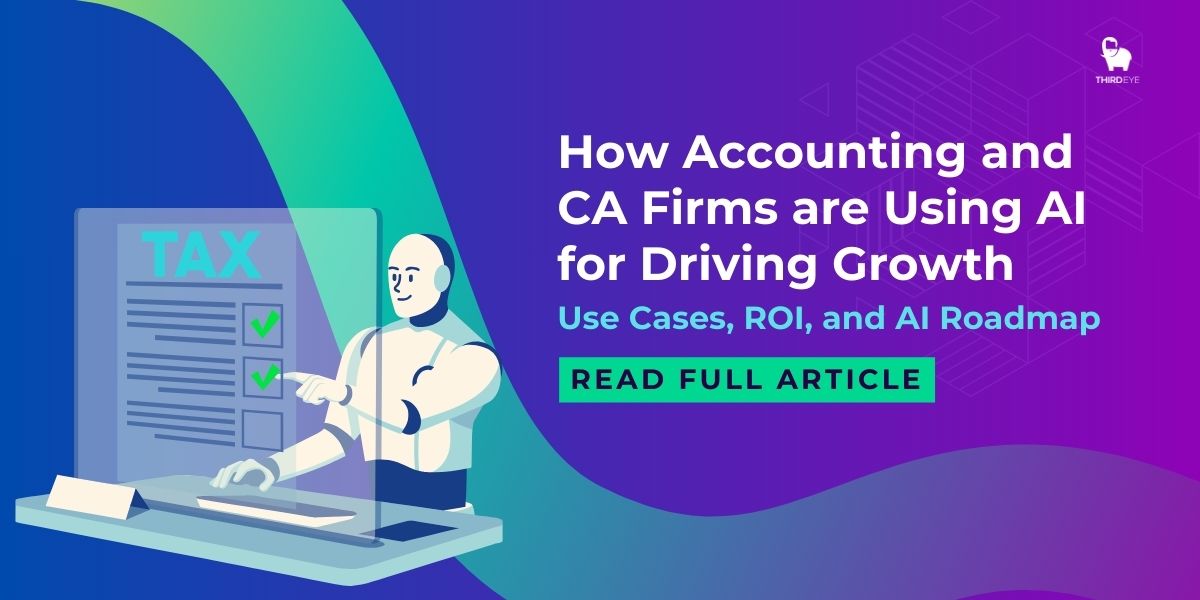Explore 20+ AI Solution Prototypes at Our AI Demo Central |

As businesses are operating in a data-heavy and compliance-driven accounting environment, AI is not just a futuristic idea anymore, it has become a non-avoidable strategic move. Various AI solutions are emerging as a catalyst to modernize operations, reduce manual effort, and drive higher margins for accounting and CA firms.
In this article, we will explore how accounting firms are using AI effectively, the key use cases with quantified ROI, usual investment considerations by firm size, and a robust step-by-step strategy to maximize returns, based on ThirdEye Data’s experience building enterprise-grade AI solutions for global clients.
For accounting firms that still rely on manual workflows or legacy systems, we would like to recommend them exploring the possibilities AI brings on the table and utilize the opportunity to leapfrog into the next era of efficiency.
After working with multiple finance and consulting firms, wehaveidentifiedsome of the most impactful, automation-ready areasfor AI deploymentfor accounting and CA firms:
| Use Case | Impact |
|---|---|
| Automated Data Extraction | Extract data from invoices, bank statements, PDFs in seconds |
| AI-Powered Bank Reconciliation | Auto-match transactions across books and banks |
| Anomaly Detection in Expenses | Flag unusual patterns, duplicates, or compliance risks |
| Tax Preparation Assistance (LLMs) | Auto-classify transactions, pre-fill forms, summarize obligations |
| Audit Analytics & Risk Detection | Identify fraud, misstatements, and irregularities proactively |
| Client Chatbot for Queries | Respond to tax, filing, or billing questions instantly |
| Financial Forecasting & Advisory | Generate predictive cash flow, budgeting, and profitability reports |
| Intelligent Document Management | Auto-organize, classify, and retrieve files with metadata tagging |
Note: We haveintentionally excluded RPA (Robotic Process Automation) from this analysis to maintainfocus on AI-powered systems that learn and adapt.This article mainly focuseson the use cases where businesses need not invest heavy amountsand start getting the benefits on immediatebasis.
AI implementation isnotjust about automation,itisabout digital transformationthat impactsROI positively. Here’show each use case stacks up:
| Use Case | Annual Savings/Gain | AI Cost | Net ROI | ROI % |
|---|---|---|---|---|
| Data Extraction | $46,080 | $12,000 | $34,080 | 285% |
| Bank Reconciliation | $17,280 | $6,000 | $11,280 | 188% |
| Expense Anomaly Detection | $7,000 | $3,000 | $4,000 | 133% |
| Tax Assistance (per client) | $14,400 | $6,000 | $8,400 | 140% |
| Audit Analytics | $35,000 | $15,000 | $20,000 | 133% |
| Client Chatbot | $10,800 | $5,000 | $5,800 | 116% |
| Financial Forecasting & Upselling | $20,000 | $7,000 | $13,000 | 186% |
| Document Management | $6,480 | $3,500 | $2,980 | 85% |
Conclusion:Even with modest investments, AI brings 2x–4x returns annually, especially in labor-heavy and client-interfacing tasks.And these are not some randomdata, we are sharing these stats based on performance of our AI solutions, deployed for the Banking & Finance industry.
Small Firms (Considering Firms with 5–20 employees)
Mid-Sized Firms (Considering Firms with 20–100 employees)
Large Firms / MNCs (Considering Firms with 100+ employees)
Assess Current Workflows
Define Business Goals for AI Applications
Evaluate Data Readiness
Choose the Right Tools
Pilot with High-Impact Use Cases
Train Your Team
Ensure Integration
Monitor and Optimize
| Parameter | Why It Matters |
|---|---|
| Use Case ROI Potential | Focus on tasks where automation gives quick, measurable gains |
| Data Availability | Clean, digitized data boosts AI efficiency |
| Tool Compatibility | Ease of integration accelerates adoption |
| Team Buy-In | Adoption depends on confidence and training |
| Scalability | Choose tools that grow with your business |
| Security & Compliance | Financial data requires AI systems with strong safeguards |
AI is not about replacing accountants, it is about empowering them with high-end precision, speed, and insight. At ThirdEye Data, we help accounting and CA firms to use AI for their unique use cases with pre-built and custom AI models.
Whether you want to automate bank reconciliations, extract data from documents, or deliver smart financial forecasts to your clients, AI technologies can deliver real-world ROI within months, not years.
References:
“AI in Accounting: Transforming the Profession with 85% Efficiency Gains,” OBS Business.
“Transforming the Industry: AI in Accounting and Finance,” SandTech.
“The Evolving Impact of AI in Finance & Accounting,” Oggi Talent.
“The Rise of Automation in Accounting,” ACCA Global.
ai solutions, assistants, predictive analytics, ai development, google cloud, thirdeye data, big data solutions, data engineering, data science services, thirdeye, data engineering services, software development, ecotrak